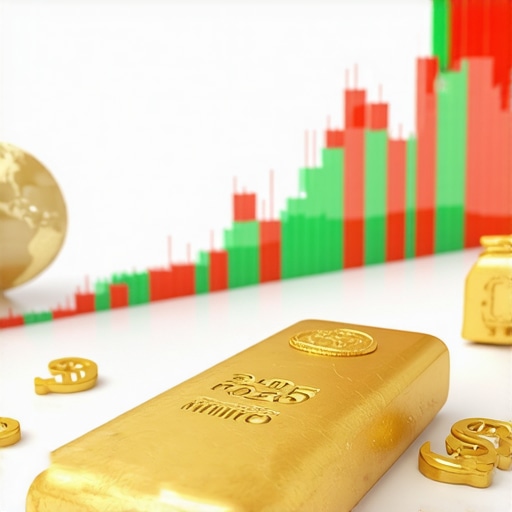As we move into 2025, the dynamics of gold demand are expected to evolve significantly, influenced by various economic, geopolitical, and market factors. Understanding these trends is essential for investors and enthusiasts alike who want to navigate the gold market effectively.
Key Factors Influencing Gold Demand in 2025
The demand for gold is shaped by several critical elements, including economic uncertainty, inflation rates, and shifts in consumer behavior. In times of economic instability, investors often flock to gold as a safe-haven asset, which increases its appeal. With ongoing global economic challenges, such as inflationary pressures and fluctuating currencies, gold’s role as a hedge against these uncertainties cannot be overstated.
Inflation and Its Impact on Gold Prices
Inflation has historically shown a strong correlation with gold prices. In 2025, as central banks grapple with rising inflation, many investors are expected to turn to gold to preserve their purchasing power. This trend can lead to increased demand, potentially driving prices higher. For detailed insights on this topic, you may want to explore the relationship between gold and inflation.
Geopolitical Factors and Gold Demand
Geopolitical tensions often lead to increased gold demand. In 2025, issues such as international trade disputes and regional conflicts may play a crucial role in shaping investor sentiment. When uncertainty looms, gold’s status as a tangible asset tends to attract capital seeking safety. Investors should stay informed about geopolitical developments, as they can significantly impact gold prices.
Moreover, the gold market analysis indicates that emerging markets are likely to increase their gold consumption as their economies grow. Countries such as India and China have a long-standing cultural affinity for gold, and as their middle classes expand, the demand for gold jewelry and investment products is expected to rise.
Investment Strategies for 2025
With the landscape of gold demand expected to shift, investors should consider diversifying their portfolios. Options like gold ETFs, gold bullion, and gold stocks can provide exposure to the market without the need for physical storage. By understanding gold demand trends, investors can make informed decisions aligned with their financial goals.
In conclusion, monitoring the evolving landscape of gold demand in 2025 will be paramount for investors. By keeping an eye on economic indicators, geopolitical events, and consumer behavior, individuals can better position themselves to capitalize on the opportunities that arise in the gold market. For further insights into the nuances of gold investment, consider reading our comprehensive guide on buying gold.
Understanding Gold Investment Options
As we further explore the gold investment landscape in 2025, it’s essential to understand the various options available to investors. From physical assets like gold bullion and coins to financial instruments such as gold ETFs, investors have numerous avenues to consider. Each option comes with its own set of advantages and disadvantages, which can significantly impact overall returns.
Physical Gold vs. Gold ETFs
One of the critical decisions investors face is whether to invest in physical gold or gold exchange-traded funds (ETFs). While physical gold provides the security of owning a tangible asset, gold ETFs offer liquidity and ease of trading. As investors navigate their options, understanding the benefits of gold ETFs can help them make informed choices that align with their investment strategies.
Gold Bullion vs. Gold Coins: Making the Right Choice
When considering physical gold investments, another crucial factor is whether to buy gold bullion or gold coins. Each has unique attributes that cater to different investment goals. Gold bullion is often favored for its lower premiums, making it a cost-effective option for bulk purchases. In contrast, gold coins often have numismatic value, which can appeal to collectors and investors alike. For those unsure about their choice, our article on gold bullion vs. gold coins provides valuable insights.
Maximizing Returns with Gold Mutual Funds
Investing in gold mutual funds is another attractive option for those looking to gain exposure to gold without the complexities of physical ownership. These funds pool resources from multiple investors to purchase shares in companies involved in gold mining or production. Understanding the best gold mutual funds can help investors optimize their portfolios and maximize potential returns.
Strategies for Investing in Gold Stocks
For investors willing to take on more risk, gold stocks can provide significant opportunities for growth. Investing in gold mining companies offers exposure to the performance of the underlying asset while also allowing investors to benefit from the operational efficiencies and management strategies of these businesses. However, it’s crucial to conduct thorough research and analysis, especially when evaluating gold stocks for potential inclusion in your investment strategy.
Gold IRAs: Secure Your Retirement Savings
Another compelling option for long-term investors is a gold IRA. This retirement account allows investors to hold physical gold and other precious metals, offering a hedge against inflation and market volatility. As more individuals consider retirement planning, understanding the benefits and requirements of a gold IRA can be instrumental in building a secure financial future.
The Role of Gold in a Diversified Portfolio
As global economic conditions evolve, integrating gold into an investment portfolio can enhance overall stability. Gold typically has a low correlation with other asset classes, making it an ideal hedge against market fluctuations. Investors should consider this dynamic when crafting a diversified portfolio that includes gold along with stocks, bonds, and other financial instruments.
Conclusion: Navigating the Future of Gold Investment
In summary, understanding the intricacies of gold investments is paramount for navigating the opportunities that 2025 presents. From evaluating different investment avenues like gold prices to leveraging strategic insights on market trends, investors can position themselves to capitalize on the evolving gold landscape.
Analyzing Gold Demand Trends in 2025
As we look ahead to 2025, understanding the gold demand trends becomes increasingly crucial for investors. Various factors influence gold demand, including economic performance, geopolitical stability, and shifts in investor sentiment. The growing interest in gold as a hedge against inflation has created a robust market for gold investments, making it essential to stay informed about the latest trends.
The Impact of Central Banks on Gold Demand
Central banks play a pivotal role in shaping the demand for gold. In recent years, many central banks around the world have increased their gold reserves as part of their monetary policies. This trend is likely to continue in 2025 as countries seek to diversify their assets and protect against currency fluctuations. The role of central banks in gold investment strategies cannot be overstated, as their buying patterns significantly influence market prices and investor confidence.
Investor Behavior and Market Sentiment
Investor behavior also significantly impacts gold demand. Market sentiment can shift rapidly due to economic news, geopolitical events, or changes in interest rates. For example, during times of economic uncertainty, investors often flock to gold as a safe-haven asset. Understanding how to predict these shifts can be advantageous for those looking to enter the market. Our post on gold price predictions provides insights into how these trends might unfold in 2025.
Gold Demand in Emerging Markets
Emerging markets, particularly in Asia, are expected to drive a significant portion of gold demand in the coming years. Countries like India and China have a long history of gold consumption, particularly for jewelry and cultural purposes. As disposable incomes rise in these regions, demand for gold is projected to increase. Investors should monitor these markets closely, as changes in demand can impact global prices. For those interested in a more detailed analysis, our article on exploring gold demand trends offers valuable insights.
The Environmental Impact of Gold Mining
Another factor affecting gold demand is the growing awareness of the environmental impact of gold mining. Investors are increasingly considering sustainable practices when making investment decisions. Companies that demonstrate a commitment to ethical mining practices may attract more investment, influencing the overall demand for gold. Understanding the profitability of gold mining stocks within this context can provide a comprehensive view of potential investment opportunities.
Conclusion: Preparing for Changes in Gold Demand
As we approach 2025, the landscape of gold demand is set to evolve significantly. By staying informed about the factors influencing demand, including central bank actions and market dynamics, investors can position themselves strategically for the future. Emphasizing a diversified approach—integrating physical gold, ETFs, and mining stocks—will be crucial for maximizing returns in this ever-changing market.
Gold Investment Opportunities: What to Look For
As we explore the landscape of gold investment opportunities in 2025, it’s essential to consider a variety of factors that influence the market. Investors should focus on understanding the different avenues available for investment, including physical gold, gold ETFs, mining stocks, and gold futures. By diversifying within these categories, investors can effectively manage risk while maximizing potential returns.
Physical Gold: A Tangible Asset
Investing in physical gold remains a popular choice for many investors seeking to hedge against economic uncertainty. Gold bars and coins are not only a store of value but also provide a sense of security that digital assets may lack. However, it’s crucial to assess the best practices for buying gold bullion to ensure that you are making informed decisions. This includes knowing how to authenticate gold, understanding the premiums associated with purchasing, and choosing the right dealers.
Gold ETFs: A Convenient Option
Gold exchange-traded funds (ETFs) offer a more convenient way to invest in gold without the need to manage physical assets. These funds track the price of gold and can be traded like stocks on major exchanges. Investors interested in this option should explore how to maximize gains with gold ETFs and evaluate the specific funds available in the market. Selecting ETFs that have low expense ratios and good liquidity can enhance your investment strategy.
Mining Stocks: Leverage in Gold Prices
Investing in gold mining stocks can provide leveraged exposure to the price of gold. When gold prices rise, mining stocks often outperform the commodity itself due to increased profit margins. However, this avenue also comes with additional risks associated with mining operations. To gain a better understanding of the potential rewards and risks, consider reading our article on the profitability of gold mining stocks. This resource will help you identify which companies are well-positioned to benefit from rising gold prices.
Assessing Market Conditions for Gold Investments
As an investor, keeping an eye on market conditions is vital when considering gold investments. Key factors such as inflation rates, currency strength, and geopolitical tensions can significantly influence gold prices. For instance, during periods of high inflation, gold often serves as a reliable hedge, prompting increased demand. By monitoring these conditions, investors can make timely decisions that align with market trends.
Importance of Economic Indicators
Economic indicators play a crucial role in forecasting gold prices. For example, the gold price forecast for 2025 will depend heavily on factors like interest rates and employment data. Understanding how these indicators work together can offer insights into potential price movements. Investors need to stay updated on economic reports and analyses to gauge market sentiment accurately.
Geopolitical Events and Their Impact on Gold Prices
Geopolitical events can create significant volatility in the gold market. Situations such as trade wars, political instability, and military conflicts can drive investors towards gold as a safe-haven asset. Developing a keen awareness of global affairs is essential for any investor looking to navigate the complexities of the gold market. Our post on the impact of economic events on gold prices explores how these dynamics operate and how investors can prepare for potential fluctuations.
Building a Well-Rounded Gold Investment Portfolio
To maximize potential returns, it’s vital to build a well-rounded gold investment portfolio. This includes a mix of physical gold, ETFs, and mining stocks that align with your investment goals and risk tolerance. Each investment type serves a different purpose and can help mitigate risks associated with market volatility.
Diversification Strategies
Diversification within your gold investments can shield your portfolio from unexpected downturns. For instance, while physical gold provides stability, gold stocks can offer growth potential. Consider incorporating a mix of both to achieve a balanced approach. Additionally, explore options like gold IRAs for long-term retirement planning, which can further enhance your diversification strategy.
Staying Informed and Adapting
The gold market is continually evolving, and staying informed is key. Regularly reviewing market analyses and expert predictions can help you adapt your strategy as necessary. Resources like our gold market analysis will keep you updated on current trends and future predictions, enabling you to make informed decisions in your investment journey.
Conclusion: Navigating the Future of Gold Investments
As we move towards 2025, understanding the dynamics of gold investments will be paramount. By exploring various investment opportunities, assessing market conditions, and building a diversified portfolio, you can position yourself for success in the evolving gold market. Whether you opt for physical gold, ETFs, mining stocks, or a combination of these strategies, staying informed and adaptable will be your best tools in navigating this landscape. With the right approach, investing in gold can continue to be a rewarding endeavor amid changing economic conditions.
Frequently Asked Questions about Gold Investments
What are the best gold investment options for beginners?
For beginners, investing in gold ETFs and physical gold, such as coins or bars, is often recommended. These options provide a straightforward way to gain exposure to gold without the complexities of mining stocks.
How do gold prices react during economic downturns?
During economic downturns, gold prices typically rise as investors seek safe-haven assets. Gold is often viewed as a hedge against inflation and economic instability, which can drive demand higher.
Are gold mining stocks a good investment?
Gold mining stocks can offer leveraged exposure to gold prices, meaning they may outperform physical gold during price increases. However, they come with operational risks and should be approached with caution.
What is the role of inflation in gold investments?
Inflation generally increases the demand for gold, as it is seen as a hedge against declining purchasing power. Investors often turn to gold during periods of high inflation to preserve their wealth.
How can I safely store physical gold investments?
Physical gold should be stored in a safe, secure location. Options include home safes, bank safety deposit boxes, or specialized storage facilities. It’s crucial to ensure that your investment is protected against theft and damage.
What factors should I consider when choosing gold ETFs?
When choosing gold ETFs, consider factors such as the fund’s expense ratio, liquidity, tracking error, and the amount of physical gold held. Selecting well-managed ETFs can significantly impact your overall returns.
Can I include gold in my retirement accounts?
Yes, you can include gold in retirement accounts through gold IRAs. This allows you to invest in physical gold while benefiting from tax advantages typically associated with retirement accounts.
How often should I review my gold investment portfolio?
It is advisable to review your gold investment portfolio at least annually or whenever there are significant changes in market conditions or your financial goals. Staying informed will help you manage your investments effectively.
What are the risks associated with gold investments?
The risks include market volatility, price fluctuations, and geopolitical influences. Additionally, investing in mining stocks carries operational risks. Understanding these risks can help you make informed decisions.
Where can I find authoritative resources on gold investments?
You can explore resources from reputable financial websites, government publications, and investment analysis platforms. Organizations like the World Gold Council and financial news outlets provide valuable insights into the gold market.
Final Thoughts: Embracing Gold Investment Opportunities
In conclusion, as we look towards the future of gold investments, it’s clear that understanding the various avenues available—whether through physical gold, ETFs, or mining stocks—is essential for success. Keeping informed about market conditions, economic indicators, and geopolitical events will empower investors to make strategic decisions. By creating a diversified gold investment portfolio and utilizing the resources available, you can navigate the complexities of the gold market with confidence. As you embark on your investment journey, remember that gold can be a valuable addition to your financial strategy, providing security and potential for growth in an ever-changing economic landscape.










